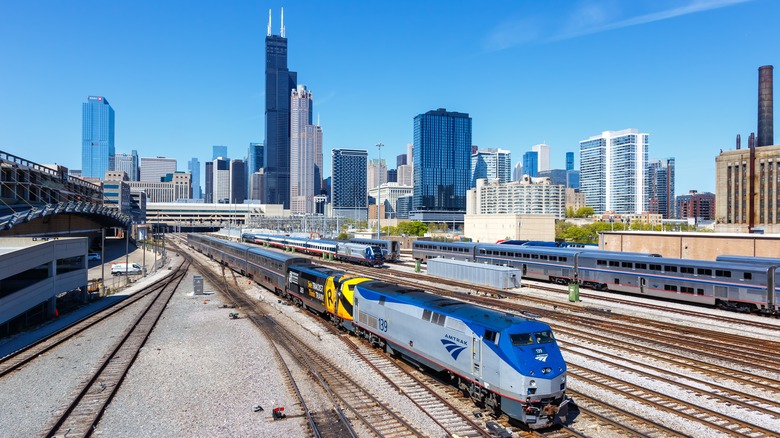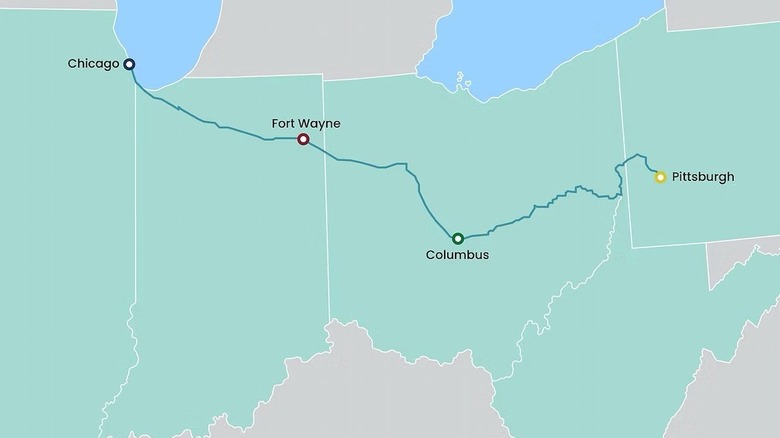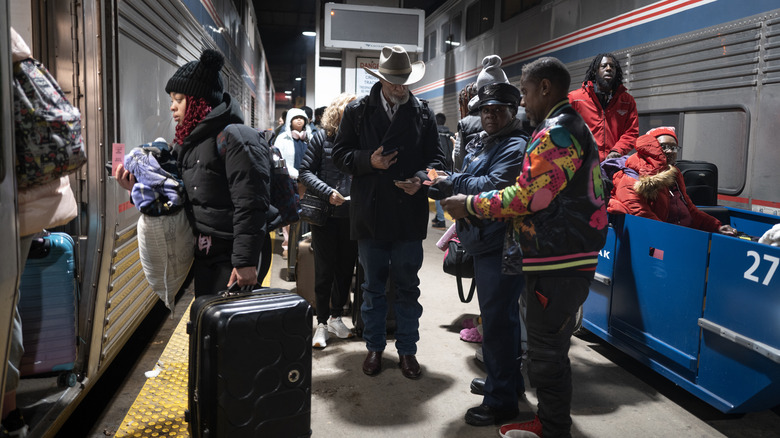There's A New Proposed Amtrak Route Called The 'Midwest Connect' That Will Link These Popular Cities
The Midwest might be getting a new five-state train route that some hope will revolutionize the region's intercity travel. Stretching from Chicago to Pittsburgh, the Federal Rail Administration-funded line is part of the Corridor Identification and Development (Corridor ID) Program, a bipartisan program initiated in 2022 and a major tenet of President Biden's infrastructure push. Interestingly, the corridor was not in Amtrak's ambitious 2035 map, first released when the president announced his $2 trillion infrastructure plan in 2021.
Instead, this proposal will stop in Fort Wayne, Indiana, and Columbus, Ohio, on its way from Chicago to Pittsburgh. The project gained momentum in October 2025, when the Southwestern Pennsylvania Commission, Mid-Ohio Regional Planning Commission (MORPC), the city of Fort Wayne, and several Ohio cities pledged a combined $650,000 to advance the rail project. Despite the enthusiasm, Midwest Connect has a long way to go before becoming a reality.
As it stands, the railway is in the first of three steps in its planning phase, where relevant partners gather information and funding for a Service Development Plan. If approved, the project will proceed to a final design and construction before becoming operational. As part of a larger push to update the Midwest's rail system, the region is looking to maximize the Corridor ID Program to reinvigorate its intercity connections. Another Midwest Connect project linking Cincinnati, Dayton, Columbus, and Cleveland, dubbed 3C&D, has just moved into its second planning phase. And while the 545-mile route from Chicago to Pittsburgh is far from one of the world's longest train lines, the project would be a major step in addressing the region's infrastructure needs.
Connecting the Midwest
While the FRA's Corridor ID program is relatively new, local and regional authorities have prepared the project for over a decade. Midwest Connect is spearheaded by three regional organizations: the Mid-Ohio Regional Planning Commission, the Southwestern Pennsylvania Commission, and the City of Fort Wayne. Several smaller, localized groups and city governments are also involved in the project. Most of its funding is expected to come from the Federal Railroad Administration. Already, the City of Fort Wayne has received a grant from the FRA to complete step one of the project.
However, its local partners will fund the remaining 20% of the planning stages. While the recent injection of funds will help propel the project toward step 2, the group is still raising funds to complete the second step of the planning stage, when most of the project's details, including station locations, infrastructure development plans, and operational costs, will be determined. According to local newspaper The Columbus Dispatch, Step Two will take one to three years.
Following Step Two, the project will enter the final phase of the planning process, focusing on preliminary engineering, assessing environmental impact, and preparing the route's initial design and construction phases. The timeline for Step Three of the planning phase will also last up to three years. One important detail is that the route may change based on the Corridor ID program's findings during these preliminary phases. Once the rail line's planning stages are completed, the project will enter the final design and construction phases.
Moving toward a railway
Because the corridor depends on FRA funding, it's highly susceptible to changes in federal funding priorities. For instance, while the Biden administration advocated for passenger rail expansion, President Trump has often opposed rail projects. Recently, the administration's support has largely been along partisan lines. In October 2025, the administration froze $18 billion in funding to expand New York's train infrastructure amidst tensions over the government shutdown. Furthermore, it has attempted to redistribute $2.4 billion of federal funds for California's high-speed rail project to a nationwide $5 billion effort.
Meanwhile, Florida received $42 million in rail safety funding in September 2025. How the administration approaches a five-state project through a mix of Democratic and Republican states is uncertain. However, stakeholders should receive more clarity in the coming months, as the FRA's new administrator, David Fink, received Senate approval in October. Fink is a critical figure in the corridor's success, as each step will need to be approved by the FRA. State legislatures will also need to approve the rail lines, far from a guarantee in the current climate.
If completed, the new railway will serve a metro area of roughly 14.7 million people. According to the MORPC, the project could create 1 million jobs by 2040. Furthermore, while Amtrak trains aren't setting any speed records, the line could make commutes 46% more environmentally efficient, providing huge dividends in an era where climate concerns continue to rise. These benefits are much needed in an area severely underserved by America's rail system. As it stands, Columbus, Ohio, is the largest U.S. city without passenger rail, having shut down its rail network in 1979. Fort Wayne, meanwhile, hasn't sported a passenger rail system since 1990.


